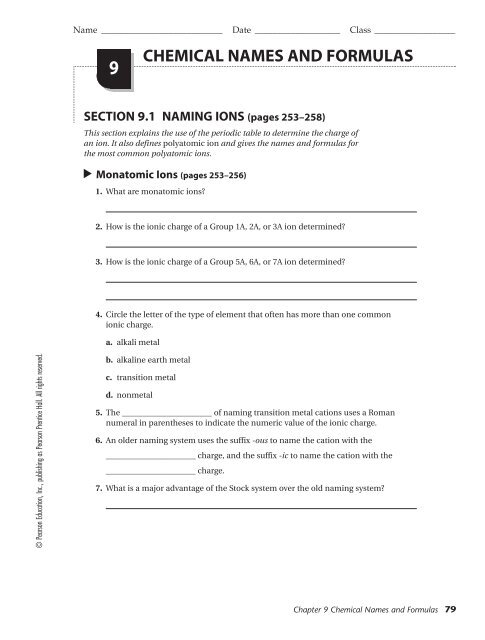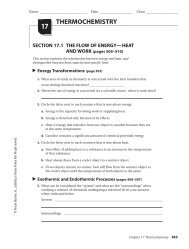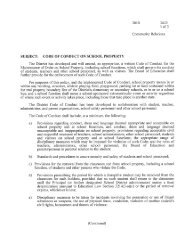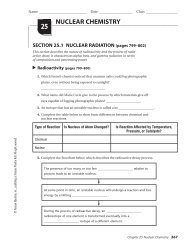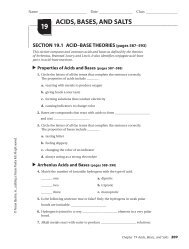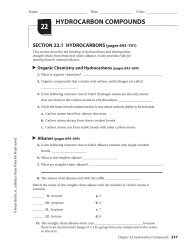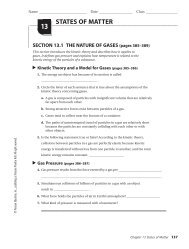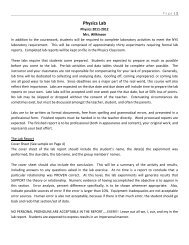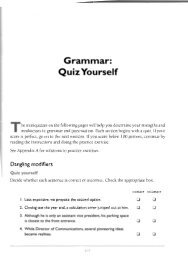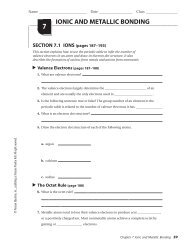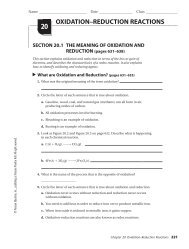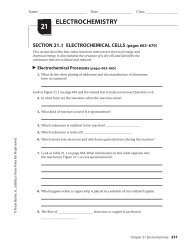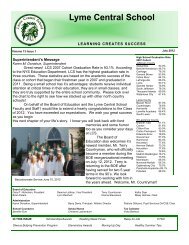Guided Reading - Bonar Law Memorial
Guided Reading - Bonar Law Memorial
Guided Reading - Bonar Law Memorial
Create successful ePaper yourself
Turn your PDF publications into a flip-book with our unique Google optimized e-Paper software.
Name ___________________________ Date ___________________ Class __________________<br />
9<br />
CHEMICAL NAMES AND FORMULAS<br />
SECTION 9.1 NAMING IONS (pages 253–258)<br />
This section explains the use of the periodic table to determine the charge of<br />
an ion. It also defines polyatomic ion and gives the names and formulas for<br />
the most common polyatomic ions.<br />
Monatomic Ions (pages 253–256)<br />
1. What are monatomic ions?<br />
Monatomic ions are ions consisting of only one atom.<br />
2. How is the ionic charge of a Group 1A, 2A, or 3A ion determined?<br />
The ionic charge is numerically equal to the group number.<br />
3. How is the ionic charge of a Group 5A, 6A, or 7A ion determined?<br />
The charge of an ion in Groups 5A, 6A, or 7A is determined by subtracting 8 from<br />
the group number.<br />
4. Circle the letter of the type of element that often has more than one common<br />
ionic charge.<br />
a. alkali metal<br />
© Pearson Education, Inc., publishing as Pearson Prentice Hall. All rights reserved.<br />
b. alkaline earth metal<br />
c. transition metal<br />
d. nonmetal<br />
5. The ______________________ Stock system of naming transition metal cations uses a Roman<br />
numeral in parentheses to indicate the numeric value of the ionic charge.<br />
6. An older naming system uses the suffix -ous to name the cation with the<br />
______________________ lesser charge, and the suffix -ic to name the cation with the<br />
______________________ greater charge.<br />
7. What is a major advantage of the Stock system over the old naming system?<br />
The Stock system gives the actual charge of the ion.<br />
Chapter 9 Chemical Names and Formulas 79
© Pearson Education, Inc., publishing as Pearson Prentice Hall. All rights reserved.<br />
Name ___________________________ Date ___________________ Class __________________<br />
CHAPTER 9, Chemical Names and Formulas (continued)<br />
8. Use the periodic table to write the name and formula (including charge) for<br />
each ion in the table below.<br />
Element Name Formula<br />
Fluorine<br />
Calcium<br />
Oxygen<br />
fluoride ion<br />
calcium ion<br />
oxide ion<br />
F –<br />
Ca 2+<br />
O 2–<br />
Polyatomic Ions (pages 257–258)<br />
9. What is a polyatomic ion?<br />
A polyatomic ion is a tightly bound group of atoms that behaves as a unit and carries<br />
a charge.<br />
10. Is the following sentence true or false? The names of polyatomic anions always<br />
end in -ide. ______________________<br />
false<br />
11. What is the difference between the anions sulfite and sulfate?<br />
The sulfite ion has one less oxygen atom than the sulfate ion.<br />
12. Look at Table 9.3 on page 257. Circle the letter of a polyatomic ion that is a cation.<br />
a. ammonium<br />
b. acetate<br />
c. oxalate<br />
d. phosphate<br />
13. How many atoms make up the oxalate ion and what is its charge?<br />
It is made up of 6 atoms (2 carbon atoms and 4 oxygen atoms) and it has a charge<br />
of 2.<br />
14. What three hydrogen-containing polyatomic anions are essential components<br />
of living systems?<br />
a. ____________________________________________<br />
hydrogen carbonate ion<br />
b. ____________________________________________<br />
hydrogen phosphate ion<br />
c. ____________________________________________<br />
dihydrogen phosphate ion<br />
80 <strong>Guided</strong> <strong>Reading</strong> and Study Workbook
Name ___________________________ Date ___________________ Class __________________<br />
15. Look at Figure 9.5 on page 257. Identify each of the ions shown below.<br />
N<br />
1<br />
P<br />
3<br />
N<br />
1<br />
ammonium ion<br />
a. __________________ b. ______________________<br />
phosphate ion nitrate ion<br />
c. ______________________<br />
SECTION 9.2 NAMING AND WRITING FORMULAS FOR<br />
IONIC COMPOUNDS (pages 260–266)<br />
This section explains the rules for naming and writing formulas for binary<br />
ionic compounds and compounds containing a polyatomic ion.<br />
Binary Ionic Compounds (pages 260–263)<br />
1. Traditionally, common names were based on some ______________________ property of<br />
a compound or its ______________________ source .<br />
2. What is the general name for compounds composed of two elements?<br />
They __________________________________________________<br />
are binary compounds.<br />
3. When writing the formula for any ionic compound, the charges of the ions<br />
must ______________________ balance<br />
.<br />
4. What are two methods for writing a balanced formula?<br />
© Pearson Education, Inc., publishing as Pearson Prentice Hall. All rights reserved.<br />
a. ____________________________________________________________________<br />
finding the least common multiple of the charges<br />
b. ____________________________________________________________________<br />
using the crisscross method<br />
5. What are the formulas for the compounds formed by the following pairs of ions?<br />
a. Fe 2 , Cl ______________________<br />
FeCl 2<br />
b. Cr 3 , O 2 ______________________<br />
Cr 2 O 3<br />
c. Na , S 2 ______________________<br />
Na 2 S<br />
6. What are the formulas for these compounds?<br />
a. lithium bromide ______________________<br />
LiBr<br />
b. cupric nitride ______________________<br />
Cu 3 N 2<br />
MgCl 2<br />
c. magnesium chloride ______________________<br />
7. The name of a binary ionic compound is written with the name of the<br />
______________________ cation<br />
first followed by the name of the ______________________ anion .<br />
Chapter 9 Chemical Names and Formulas 81
© Pearson Education, Inc., publishing as Pearson Prentice Hall. All rights reserved.<br />
Name ___________________________ Date ___________________ Class __________________<br />
CHAPTER 9, Chemical Names and Formulas (continued)<br />
8. How can you tell that cobalt(II) iodide is a binary ionic compound formed<br />
by a transition metal with more than one ionic charge?<br />
The name includes a Roman numeral representing the ionic charge of the transition<br />
metal cation.<br />
9. Write the names for these binary ionic compounds.<br />
a. PbS __________________________________<br />
lead(II) sulfide<br />
b. MgCl 2 __________________________________<br />
magnesium chloride<br />
c. Al 2 Se 3 __________________________________<br />
aluminum selenide<br />
Compounds with Polyatomic Ions (pages 264–266)<br />
10. What is a polyatomic ion?<br />
A polyatomic ion contains more than one element.<br />
11. How do you write the formula for a compound containing a polyatomic ion?<br />
Write the symbol for the cation followed by the formula for the polyatomic ion<br />
and balance the charges.<br />
12. Why are parentheses used to write the formula Al(OH) 3 ?<br />
The parentheses indicate how many polyatomic ions are needed in the formula.<br />
13. Complete the table for these ionic compounds containing polyatomic ions.<br />
Cation Anion Name Formula<br />
NH 4<br />
+<br />
S 2<br />
ammonium sulfide<br />
(NH 4 ) 2 S<br />
Fe 3+<br />
CO 3<br />
2–<br />
iron(III) carbonate<br />
Fe 2 (CO 3 ) 3<br />
Ag +<br />
NO 3<br />
<br />
potassium cyanide<br />
K + CN – silver nitrate<br />
AgNO 3<br />
KCN<br />
82 <strong>Guided</strong> <strong>Reading</strong> and Study Workbook
Name ___________________________ Date ___________________ Class __________________<br />
SECTION 9.3 NAMING AND WRITING FORMULAS FOR<br />
MOLECULAR COMPOUNDS (pages 268–270)<br />
This section explains the rules for naming and writing formulas for binary<br />
molecular compounds.<br />
Naming Binary Molecular Compounds (pages 268–269)<br />
1. Circle the letter of the type(s) of elements that form binary molecular compounds.<br />
a. two nonmetallic elements<br />
b. a metal and a nonmetal<br />
c. two metals<br />
2. Is the following sentence true or false? Two nonmetallic elements can combine<br />
in only one way. ______________________<br />
false<br />
3. What method is used to distinguish between different molecular compounds<br />
that contain the same elements? _________________________________________<br />
Prefixes are used.<br />
Match the prefix with the number it indicates.<br />
_______ c 4. octa- a. 4<br />
_______ a 5. tetra- b. 7<br />
_______ b 6. hepta- c. 8<br />
_______ d 7. nona- d. 9<br />
© Pearson Education, Inc., publishing as Pearson Prentice Hall. All rights reserved.<br />
8. What are the names of the following compounds?<br />
a. BF 3 ____________________________________________<br />
boron trifluoride<br />
b. N 2 O 4 ____________________________________________<br />
dinitrogen tetroxide<br />
c. P 4 S 7 ____________________________________________<br />
tetraphosphorus heptasulfide<br />
Writing Formulas for Binary Molecular Compounds (page 270)<br />
9. What are the formulas for the following compounds?<br />
a. carbon tetrabromide ______________________<br />
CBr 4<br />
b. nitrogen triiodide ______________________<br />
NI 3<br />
c. iodine monochloride ______________________<br />
ICl<br />
d. tetraiodine nonaoxide ______________________<br />
I 4 O 9<br />
Chapter 9 Chemical Names and Formulas 83
© Pearson Education, Inc., publishing as Pearson Prentice Hall. All rights reserved.<br />
Name ___________________________ Date ___________________ Class __________________<br />
CHAPTER 9, Chemical Names and Formulas (continued)<br />
<strong>Reading</strong> Skill Practice<br />
Writing a summary can help you remember the information you have read. When you write a<br />
summary, include only the most important points. Write a summary of the information in Section 9.3<br />
on pages 268–269. Your summary should be shorter than the text on which it is based. Do your work<br />
on a separate sheet of paper.<br />
Students’ summaries should focus on the main points of each subsection and include the information<br />
given in Table 9.4.<br />
SECTION 9.4 NAMING AND WRITING FORMULAS<br />
FOR ACIDS AND BASES (pages 271–273)<br />
This section explains the three rules for naming acids and shows how these<br />
rules can also be used to write the formulas for acids. Names and formulas<br />
for bases are also explained.<br />
Naming Common Acids (pages 271–272)<br />
1. Acids produce ______________________ hydrogen ions when dissolved in water.<br />
2. When naming acids, you can consider them to be combinations of<br />
______________________ anions connected to as many ______________________ hydrogen ions<br />
as are necessary to create an electrically neutral compound.<br />
3. What is the formula for hydrobromic acid? ______________________<br />
HBr<br />
4. What are the components of phosphorous acid? What is its formula?<br />
hydrogen ion and phosphite ion; H 3 PO 3<br />
Writing Formulas for Acids (page 272)<br />
5. Use Table 9.5 on page 272 to help you complete the table about acids.<br />
Acid Name Formula Anion Name<br />
acetic acid<br />
carbonic acid<br />
hydrochloric acid<br />
nitric acid<br />
phosphoric acid<br />
sulfuric acid<br />
HC 2 H 3 O 2<br />
H 2 CO 3<br />
HCl<br />
HNO 3<br />
H 3 PO 4<br />
H 2 SO 4<br />
acetate<br />
carbonate<br />
chloride<br />
nitrate<br />
phosphate<br />
sulfate<br />
84 <strong>Guided</strong> <strong>Reading</strong> and Study Workbook
Name ___________________________ Date ___________________ Class __________________<br />
Names and Formulas for Bases (page 273)<br />
6. A base is a compound that produces ______________________ hydroxide ions when dissolved<br />
in water.<br />
7. How are bases named?<br />
Name the cation first followed by the anion (hydroxide ion).<br />
SECTION 9.5 THE LAWS GOVERNING FORMULAS<br />
AND NAMES (pages 274–279)<br />
This section uses data to demonstrate that a compound obeys the law of<br />
definite proportions. It also explains how to use flow charts to write the<br />
name and formula of a compound.<br />
The <strong>Law</strong>s of Definite and Multiple Proportions (pages 274–275)<br />
1. What is the law of definite proportions?<br />
In different samples of the same chemical compound, the masses of the elements<br />
are always present in the same proportions.<br />
2. Circle the whole-number mass ratio of Li to Cl in LiCl. The atomic mass of Li is<br />
6.9; the atomic mass of Cl is 35.5.<br />
a. 42 : 1<br />
© Pearson Education, Inc., publishing as Pearson Prentice Hall. All rights reserved.<br />
b. 5 : 1<br />
c. 1 : 5<br />
3. Circle the whole-number mass ratio of carbon to hydrogen in C 2 H 4 . The<br />
atomic mass of C is 12.0; the atomic mass of H is 1.0.<br />
a. 1 : 6 c. 1 : 12<br />
b. 6 : 1 d. 12 : 1<br />
4. In the compound sulfur dioxide, a food preservative, the mass ratio of sulfur to<br />
oxygen is 1 : 1. An 80-g sample of a compound composed of sulfur and oxygen<br />
contains 48 g of oxygen. Is the sample sulfur dioxide? Explain.<br />
No; If the sample contains 48 g of oxygen, it contains 32 g of sulfur. The ratio 32 : 48<br />
is equivalent to 2 : 3, not 1 : 1.<br />
5. What is the law of multiple proportions?<br />
When two elements form more than one compound, the different masses of one<br />
element that combine with the same mass of the other element are in a ratio of<br />
small whole numbers.<br />
Chapter 9 Chemical Names and Formulas 85
© Pearson Education, Inc., publishing as Pearson Prentice Hall. All rights reserved.<br />
Name ___________________________ Date ___________________ Class __________________<br />
CHAPTER 9, Chemical Names and Formulas (continued)<br />
6. Complete the table using the law of multiple proportions.<br />
Mass of Cu Mass of Cl Mass Ratio Whole-number<br />
Cl : Cu Ratio of Cl<br />
Compound A 8.3 g 4.6 g<br />
0.55<br />
1<br />
Compound B 3.3 g 3.6 g<br />
1.1 2<br />
Practicing Skills: Naming Chemical Compounds (pages 276–277)<br />
7. How can a flowchart help you to name chemical compounds?<br />
It gives step-by-step directions for naming a compound.<br />
8. Use the flowchart in Figure 9.20 on page 277 to write the names of the<br />
following compounds:<br />
a. CsCl ___________________________________<br />
cesium chloride<br />
b. SnSe 2 ___________________________________<br />
tin(IV) selenide<br />
c. NH 4 OH ___________________________________<br />
ammonium hydroxide<br />
d. HF ___________________________________<br />
hydrofluoric acid<br />
e. Si 3 N 4 ___________________________________<br />
trisilicon tetranitride<br />
9. Complete the following five rules for writing a chemical formula from a<br />
chemical name.<br />
a. In an ionic compound, the net ionic charge is ______________________ zero<br />
.<br />
b. An -ide ending generally indicates a ______________________ binary compound.<br />
c. An -ite or -ate ending means there is a ______________________ polyatomic ion that<br />
includes oxygen in the formula.<br />
d. ______________________ Prefixes<br />
in a name generally indicate that the compound is<br />
molecular and show the number of each kind of atom in the molecule.<br />
e. A ______________________ Roman numeral after the name of a cation shows the ionic charge<br />
of the cation.<br />
86 <strong>Guided</strong> <strong>Reading</strong> and Study Workbook
Name ___________________________ Date ___________________ Class __________________<br />
Practicing Skills: Writing Chemical Formulas (page 278)<br />
10. Fill in the missing labels from Figure 9.22 on page 278.<br />
Name of Compound<br />
Contains<br />
prefixes?<br />
no<br />
Ionic<br />
compound<br />
yes<br />
Molecular<br />
compound<br />
Uses prefixes to<br />
write formula.<br />
Identify symbols<br />
Group A<br />
elements<br />
Use Table 9.1<br />
for charges.<br />
Roman<br />
numerals<br />
Give charges<br />
for cations.<br />
Polyatomic<br />
ions<br />
Use Table 9.3<br />
for charges.<br />
© Pearson Education, Inc., publishing as Pearson Prentice Hall. All rights reserved.<br />
Balance<br />
charges<br />
Use crisscross method. Add parentheses<br />
for any multiple polyatomic ions.<br />
11. Use the flowchart in Figure 9.22 to write the formulas of the following<br />
compounds:<br />
a. potassium silicate ______________________<br />
K 2 SiO 3<br />
b. phosphorus pentachloride ______________________<br />
PCl 5<br />
c. manganese(II) chromate ______________________<br />
MnCrO 4<br />
d. lithium hydride ______________________<br />
LiH<br />
e. diiodine pentoxide ______________________<br />
I 2 O 5<br />
Chapter 9 Chemical Names and Formulas 87
© Pearson Education, Inc., publishing as Pearson Prentice Hall. All rights reserved.<br />
Name ___________________________ Date ___________________ Class __________________<br />
CHAPTER 9, Chemical Names and Formulas (continued)<br />
GUIDED PRACTICE PROBLEMS<br />
GUIDED PRACTICE PROBLEM 2 (page 256)<br />
2. How many electrons were lost or gained to form these ions?<br />
a. Fe 3 b. O 2 c. Cu <br />
Step 1. Determine the number of electrons based on the size of the charge.<br />
Step 2. Determine whether the electrons were lost or gained based on the sign<br />
of the charge.<br />
a. ________________________________________________<br />
Fe 3 lost 3 electrons.<br />
b. ________________________________________________<br />
O 2 gained 2 electrons.<br />
c. ________________________________________________<br />
Cu lost 1 electron.<br />
GUIDED PRACTICE PROBLEMS 10B AND 10C (page 263)<br />
10. Write formulas for compounds formed from these pairs of ions.<br />
b. Li + , O 2–<br />
Analyze<br />
Step 1. Do the ions combine in a 1:1 ratio?<br />
No, the charges on the ions are not equal.<br />
Solve<br />
Step 2. Use the crisscross method<br />
to balance the formula.<br />
Write the formula. ___________ Li 2 0<br />
Evaluate<br />
Li<br />
<br />
2<br />
O<br />
2 1<br />
Step 3. How do you know your formula is reasonable?<br />
The positive and negative charges are equal.<br />
88 <strong>Guided</strong> <strong>Reading</strong> and Study Workbook
Name ___________________________ Date ___________________ Class __________________<br />
c. Ca 2 , N 3<br />
Analyze<br />
Step 1. Will the calcium (Ca 2+ ) and nitride (N 3– ) ions combine in a 1 : 1 ratio?<br />
How do you know?<br />
No, because then the total charge would be negative, instead of neutral.<br />
Solve<br />
Step 2. Use the crisscross method<br />
to balance the formula.<br />
Write the formula. ___________ Ca 3 N 2<br />
Ca<br />
N<br />
3 2<br />
2<br />
3<br />
Evaluate<br />
Step 3. How do you know this formula is reasonable?<br />
The positive and negative charges are equal.<br />
© Pearson Education, Inc., publishing as Pearson Prentice Hall. All rights reserved.<br />
GUIDED PRACTICE PROBLEM 13B (page 265)<br />
13b. Write the formula for chromium(III) nitrate.<br />
• Is the compound ionic or molecular? Explain.<br />
It is ionic because it has no prefixes and it contains a metal.<br />
• Use Table 9.3 on page 257 to write the formula for<br />
NO 3<br />
–<br />
the nitrate ion. ________<br />
• Use the crisscross method to balance the formula.<br />
• Write the formula. ____________________________<br />
Cr(NO 3 ) 3<br />
Cr<br />
3<br />
(NO 3 )<br />
<br />
1 3<br />
Chapter 9 Chemical Names and Formulas 89
© Pearson Education, Inc., publishing as Pearson Prentice Hall. All rights reserved.<br />
Name ___________________________ Date ___________________ Class __________________<br />
CHAPTER 9, Chemical Names and Formulas (continued)<br />
GUIDED PRACTICE PROBLEM 34 (page 275)<br />
34. Lead forms two compounds with oxygen. One compound contains 2.98 g of<br />
lead and 0.461 g of oxygen. The other contains 9.89 g of lead and 0.763 g of<br />
oxygen. For a given mass of oxygen, what is the lowest whole-number mass<br />
ratio of lead in the two compounds?<br />
Complete the following steps to solve the problem.<br />
Step 1. Write the ratio of lead to<br />
oxygen for each compound.<br />
First compound<br />
2.98 g lead<br />
<br />
0.461 g oxygen<br />
Second compound<br />
9.89 g lead<br />
g oxygen<br />
0.763<br />
Step 2. Divide the numerator by<br />
the denominator in each ratio.<br />
6.46<br />
g lead<br />
g oxygen<br />
13.0 g lead<br />
g oxygen<br />
Step 3. Write a ratio comparing<br />
the first compound to the second.<br />
6.46 g lead/g oxygen<br />
13.0 g lead/g oxygen<br />
Step 4. Simplify. Note that this ratio<br />
has no units.<br />
0.497 roughly 1<br />
1<br />
2<br />
The mass ratio of lead per gram of oxygen in the two compounds is ______________ 1 : 2 .<br />
90 <strong>Guided</strong> <strong>Reading</strong> and Study Workbook


